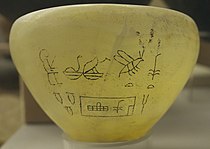Nebty name
[1][2] The Nebty name was symbolically linked to the two most important goddesses of Ancient Egyptian kingship: Nekhbet and Wadjet.
The cobra of Wadjet was worshipped as the "celestial diadem snake on the king's forehead", believed to spit fire at anyone who dared to take on the pharaoh.
This protective behaviour made Wadjet very popular and already in early dynastic times several deities were depicted as wearing a uraeus on their foreheads.
With his Nebty name each pharaoh wished to present himself as the one under the guidance and protection of the two goddesses, thus legitimizing himself as being ruler of the whole of Egypt.
Egyptologists such as Toby Wilkinson and Ludwig David Morenz point to an obvious prototype of the Nebty name used before the introduction of the final form: ivory tags from the Abydos tombs of the kings Hor-Aha and Djer and the queen Neithhotep show the Two-Ladies crest with the red crown instead of the cobra over a basket.
In the case of Hor-Aha the Nebty crest is of special interest, because it is depicted inside a three-framed building (shrine?
The first use of the final form of the Nebty crest (vulture and cobra over two baskets) appeared during the reign of king Semerkhet, who called himself Iry-Nebty ("guardian of the Two Ladies").

